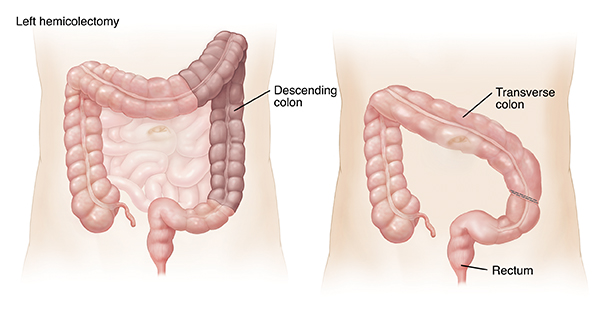Types of Colon Resections
In a colon resection, part of the colon is taken out (resected) during surgery. The most common types of colorectal resection are listed below. Your surgeon will explain the one that is right for you.
 |
| Part or all of the ascending colon and cecum are removed. The colon is then reconnected to the small intestine. |
 |
| Part or all of the descending colon is removed. The transverse colon is then reconnected to the rectum. |
 |
| Part or all of the sigmoid colon is removed. The descending colon is then reconnected to the rectum. |
 |
| The sigmoid colon and a portion of the rectum are removed. The descending colon is reconnected to the remaining rectum. |
 |
| Part or all of the sigmoid colon and the entire rectum and anus are removed. A colostomy is then performed. |
Colostomy
After surgery, the colon and rectum may need to be kept clear of stool while they heal. In other cases, the rectum has been taken out or it can’t be reconnected to the rest of the colon. In either case, you need a colostomy. This makes a new opening (stoma) in the belly (abdomen) so waste can leave the body. You may need the new opening for a short time, or permanently. If you had a colostomy during your surgery, your health care providers will help you learn how to care for it.
© 2000-2025 The StayWell Company, LLC. All rights reserved. This information is not intended as a substitute for professional medical care. Always follow your healthcare professional's instructions.